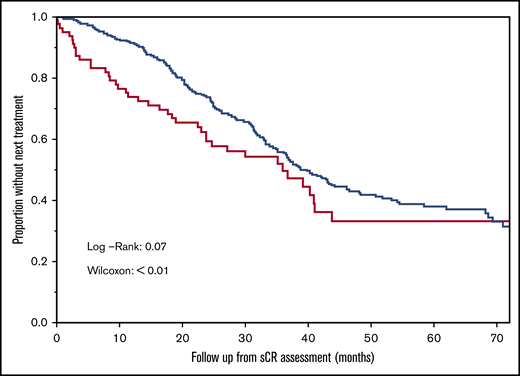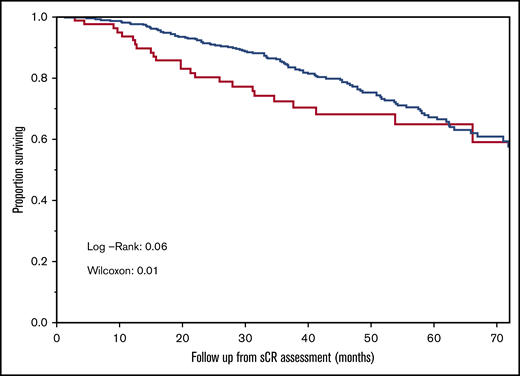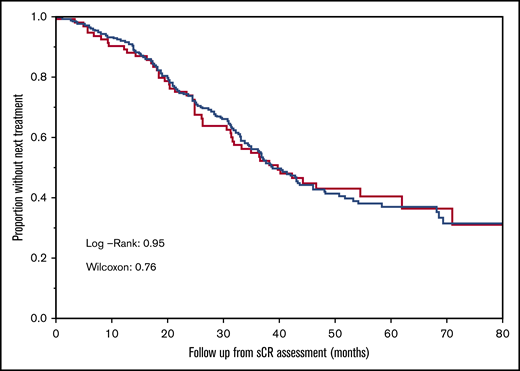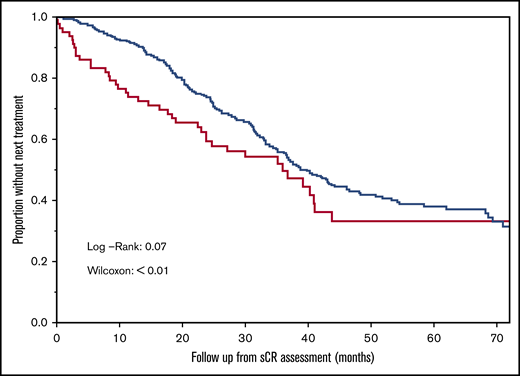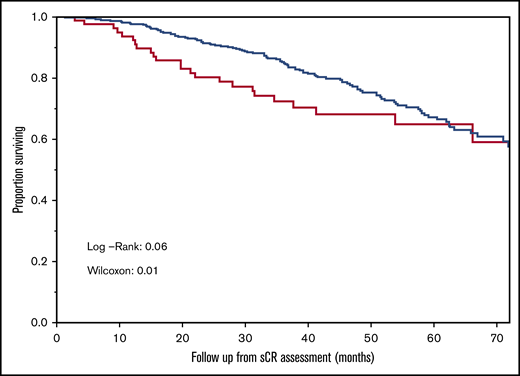Key Points
Patients with an abnormal sFLC ratio because of LC suppression have outcomes similar to those with a normal ratio.
sFLC ratio has prognostic value in patients achieving CR who have an absence of clonal BMPCs assessed by MFC.
Introduction
The treatment strategies in multiple myeloma (MM) have evolved significantly with the introduction of novel agents. Enhanced treatment efficacy translated into increased rates of complete response (CR),1 spurring efforts to distinguish deeper responses using methods with increased sensitivity to detect residual disease. Accordingly, the International Myeloma Working Group added a more stringent response category, stringent complete response (sCR), which in addition to meeting the conventional CR criteria, requires normalization of the serum free light chain (sFLC) ratio and the absence of clonal bone marrow plasma cells (BMPCs) by either immunohistochemistry or immunofluorescence, including assessment of clonality by 2- to 4-color multiparametric flow cytometry (MFC).2,3 We and others have previously shown that achievement of sCR translates to better survival outcomes compared with conventional CR alone.4,5 However, the increasing sensitivity of flow cytometry-based approaches for detecting residual myeloma cells has raised a question concerning the relevance of sFLC ratio in defining the depth of response. Therefore, the importance of understanding the added utility of the sFLC ratio in the definition of sCR in the current context has increased. Furthermore, an abnormal sFLC ratio can also be seen with light chain (LC) suppression with treatment or uninvolved LC elevation as a result of immune reconstitution.6 The impact of these changes on the prognostic value of the sFLC ratio at the time of CR is unclear. Therefore, we performed a study to evaluate the impact of sFLC ratio normalization among patients achieving a CR to treatment, including lack of clonal BMPCs by MFC, while considering the cause of sFLC abnormality.
Methods
After approval by the Mayo Clinic Institutional Review Board, medical records of patients with a diagnosis of MM from 1997 to 2017 were reviewed. We included patients who had achieved at least a CR (as best response) after first-line or subsequent lines of treatment, including stem cell transplantation (SCT)–based or non-SCT–based treatments, and had absence of clonal BMPCs as assessed by immunophenotyping using 4-color MFC with the plasma cell proliferative index (PC-PRO) and a sensitivity of 10−4. PC-PRO detects monoclonal plasma cells by using their surface immunophenotype, cytoplasmic LC restriction, and DNA content. Surface immunophenotyping was performed using CD138, CD38, CD19, and CD45 antibodies, and the DNA index was determined by double-stranded DNA staining using 4′,6-diamidino-2-phenylindole.7 We extracted data on sFLC concentrations and ratios corresponding to the date of negative bone marrow aspirate or biopsy for clonal BMPCs. sFLCs were measured by nephelometry using the Freelite test (The Binding Site, Birmingham, United Kingdom). The following reference ranges were used to define normal values: serum κ free LC, 0.33 to 1.94 mg/dL; serum λ free LC, 0.57 to 2.63 mg/dL; and sFLC κ/λ ratio, 0.26 to 1.65.8 Patients with less than a CR to treatment or without concomitant sFLC data were excluded.
Statistical analysis
Median age and the International Staging System (ISS) stage were compared between patients with normal or abnormal sFLC ratios by using the Wilcoxon rank-sum test and Fisher’s exact test, respectively. Values of P < .05 were considered statistically significant. To evaluate the association between sFLC ratio and patient outcomes, patients were grouped into 3 categories based on their sFLC ratio: (1) normal, patients with normal sFLC ratio irrespective of the absolute sFLC concentrations of involved and uninvolved LCs; (2) abn-suppressed, patients with abnormal sFLC ratio and suppression of 1 (either involved or uninvolved) or both LCs; and (3) abn-involved elevated, patients with abnormal sFLC ratio and elevation in the involved LC (κ elevated in κ myeloma or λ elevated in λ myeloma). Outcomes were measured from the date of collection of the bone marrow aspirate or biopsy that demonstrated the absence of clonal BMPCs. The primary end point was time-to-next treatment (TTNT), defined as time from sample collection to time of initiation of the subsequent treatment or time of last follow-up. Overall survival (OS) was defined as time from sample collection to time of death from any cause or time of last follow-up. Survival analyses were performed using the Kaplan-Meier method, and survival curves were compared using log-rank and Wilcoxon tests. A value of P < .05 was considered statistically significant.
Results and discussion
Baseline characteristics
In all, 503 patients who had achieved at least a CR were included in the analysis. Baseline patient characteristics are provided in Table 1. Median age was 61 years, and 281 patients (56%) were males. The diagnosis was MM in 454 patients (90%), nonsecretory myeloma in 38 (8%), and Bence Jones proteinuria in 8 (2%). Ninety percent of patients were diagnosed between 2007 and 2017. Median follow-up was 40.6 months from the date of CR assessment. CR was achieved as best response with autologous stem cell transplantation (ASCT) in 290 patients (58%), and non-ASCT approaches (including novel agents) were used for the other patients. Median time from diagnosis to CR was 10.3 months (range, 2.6-216.7 months). All patients achieved CR between 2012 and 2017. The sFLC ratio was normal in 331 patients (66%) and abnormal in 172 patients (34%). Median age was 61 years in both groups (P = .30). ISS stage was known for 298 patients with normal sFLC ratio and 158 patients with abnormal sFLC ratio. There was no statistically significant difference in the ISS stage between patients in the 2 groups (P = .18). Twelve percent of patients with normal ratio and 15% of patients with abnormal ratio had ISS stage 3 at diagnosis (P = .46). Among patients with abnormal sFLC ratios, 80 (47%) had an elevation of the involved LC, 24 (14%) had suppression of the involved LC, 45 (26%) had suppression of the uninvolved LC, and 23 (13%) had suppression of both LCs.
sFLC ratio and patient outcomes
First, we examined the TTNT in each of the 3 groups (normal, abn-suppressed, and abn-involved elevated). The TTNT curves seemed almost identical for the normal and abn-suppressed groups (Figure 1). The median TTNT was 38.8 months (95% confidence interval [CI], 35.1-46.1 months) in the normal group and 39.8 months (95% CI, 31.3-62 months) in the abn-suppressed group (log-rank test, 0.95; Wilcoxon test, 0.76). Consequently, we combined these 2 groups into a normal-abn suppressed group and compared the TTNT for the combined group with that of the abn-involved elevated group. The abn-involved elevated group had a shorter TTNT (median, 35.9 months; 95% CI, 23.7-41 months) compared with that of the normal-abn suppressed group (median, 38.8 months; 95% CI, 36.2-44.2 months; log-rank test, 0.07; Wilcoxon test, <0.01) (Figure 2). The abn-involved elevated group also had decreased OS (median OS, 74 months; 95% CI, 66.2-not reached [NR]) compared with the normal-abn-suppressed group (median OS, NR; 95% CI, 71.9-NR; log-rank test, 0.06; Wilcoxon test, 0.01) (Figure 3).
TTNT in normal and abn-suppressed groups. Comparison of the TTNT in patients with normal sFLC ratio (blue curve) and patients with abnormal sFLC ratio with suppression of 1 or both LCs (red curve).
TTNT in normal and abn-suppressed groups. Comparison of the TTNT in patients with normal sFLC ratio (blue curve) and patients with abnormal sFLC ratio with suppression of 1 or both LCs (red curve).
TTNT in normal-abn suppressed and abn-involved elevated groups. Comparison of the TTNT in patients with normal sFLC ratio or abnormal ratio as a result of suppression of 1 or both LCs (blue curve) and patients with abnormal sFLC ratio with involved LC elevation (red curve).
TTNT in normal-abn suppressed and abn-involved elevated groups. Comparison of the TTNT in patients with normal sFLC ratio or abnormal ratio as a result of suppression of 1 or both LCs (blue curve) and patients with abnormal sFLC ratio with involved LC elevation (red curve).
OS in normal-abn suppressed and abn-involved elevated groups. Comparison of OS in patients with normal sFLC ratio or abnormal ratio as a result of suppression of 1 or both LCs (blue curve) and patients with abnormal sFLC ratio with involved LC elevation (red curve).
OS in normal-abn suppressed and abn-involved elevated groups. Comparison of OS in patients with normal sFLC ratio or abnormal ratio as a result of suppression of 1 or both LCs (blue curve) and patients with abnormal sFLC ratio with involved LC elevation (red curve).
Several studies have evaluated whether outcomes are improved in patients attaining sCR compared with conventional CR, and others have evaluated the prognostic value of sFLC normalization in various response categories including CR. However, results have been conflicting.9 In a study by Kapoor et al,4 achievement of sCR after ASCT translated to longer time to progression (TTP) (median TTP, 50 vs 20 months) and improved OS (median OS, NR vs 81 months) compared with conventional CR. Similarly, a subgroup analysis in a different study showed that sCR was associated with a longer disease-free survival compared with CR (median, NR vs 29 months, hazard ratio, 3.37; P = .03).5 In contrast, Martínez-López et al10 found no significant difference in outcomes between the 2 response categories. The group also studied the prognostic value of sFLC ratio among patients with CR and found no difference in TTP or OS among patients with a normal vs an abnormal sFLC ratio. Although normalization of the sFLC ratio has been associated with improved survival,11 variable results have been reported specifically among patients with CR. In a study by Iwama et al,12 patients with CR and normal sFLC ratio had significantly longer OS compared with those who had CR and abnormal ratio (P = .023). In contrast, 2 other studies found no significant differences in survival associated with normal vs abnormal sFLC ratio among patients with CR.13,14 These conflicting results might be attributed to heterogeneity in the patient population, induction regimens, number of treatment lines before achieving CR, definitions of CR, and techniques used to assess BMPC clonality. Furthermore, this may partly be attributed to the cause of an abnormal sFLC ratio. In our study, we observed that patients with abnormal ratios resulting from LC suppression had TTNTs similar to those of patients with normal ratios.
When compared with patients with an abnormal sFLC ratio caused by involved LC elevation, the combined normal and abn-suppressed group of patients had superior outcomes. This highlights 2 important findings. First, our results suggest the incremental prognostic value of incorporating the sFLC ratio among patients achieving a CR and the absence of BMPCs by 4-color MFC. Second, among patients with an abnormal sFLC ratio, only those with an elevated involved LC should be considered as not meeting the definition of sCR. Few other studies have also considered the cause of the sFLC abnormality. For example, in a study by Singal et al,15 2 types of abnormal sFLC ratios were distinguished: concordant and discordant. Discordance indicated a discrepancy between the ratio and involved LC (ratio <0.26 for κ myeloma or >1.65 for λ myeloma). Their results suggested that only the concordant group should be considered reflective of disease. Patients with oligoclonal bands were excluded. In another study, abnormal sFLC ratios were reported in 12% of patients (17 of 142) achieving CR and absence of clonal BMPCs determined by 10-color MFC and fluorescence in situ hybridization (10−4 sensitivity). Abnormal ratios were explained by an increase or decrease in the involved LC in 12 patients and elevation in the uninvolved LC in 5 patients. None of the patients had disease progression at the last follow-up.6
Our study, in conjunction with the other studies, suggests that the sFLC ratio should be interpreted with caution, especially in the setting of CR. Our study is limited by its retrospective nature and by the variety and number of treatments used before CR was achieved. However, the use of sensitive MFC to assess monoclonality provides clearer insight on the individual role of the sFLC ratio. Our findings suggest that the current definition of sCR needs to be revised, and the definition of an abnormal sFLC ratio should be restricted to those with involved LC elevation. Meanwhile, such distinction should be made in clinical studies, and management should be guided by careful interpretation of the sFLC ratio. Finally, we need to continue to evaluate the role of sFLC in the context of increasing use of minimal residual disease negativity.
Authorship
Contribution: N.A. and S.K.K. collected and analyzed the data, wrote the first draft, and approved the final version of the manuscript; and P.K., D.L.M., F.K.B., D.D., A.D., M.A.G., R.S.G., W.I.G., S.R.H., T.V.K., M.Q.L., N.L., J.A.L., E.M., R.W., R.A.K., and S.V.R. managed patients, revised the manuscript critically, and approved the final version of the manuscript.
Conflict-of-interest disclosure: P.K. received research funding from Takeda Pharmaceuticals, Celgene, and Amgen. A.D. received research funding from Celgene, Millennium Pharmaceuticals, Pfizer, and Janssen, and received a travel grant from Pfizer. M.A.G. served as a consultant for Millennium Pharmaceuticals and received honoraria from Celgene, Millennium Pharmaceuticals, Onyx Pharmaceuticals, Novartis, GlaxoSmithKline, Prothena, Ionis Pharmaceuticals, and Amgen. M.Q.L. received research funding from Celgene. N.L. serves on an advisory board for Takeda Pharmaceuticals. S.K.K. served as a consultant for Celgene, Millennium Pharmaceuticals, Onyx Pharmaceuticals, Janssen, and Bristol-Myers Squibb, and received research funding from Celgene, Millennium Pharmaceuticals, Novartis, Onyx Pharmaceuticals, AbbVie, Janssen, and Bristol-Myers Squibb. The remaining authors declare no competing financial interests.
Correspondence: Shaji K. Kumar, Division of Hematology, Mayo Clinic, 200 First St SW, Rochester, MN 55905; e-mail: kumar.shaji@mayo.edu.
References
Author notes
Data sharing requests may be sent via e-mail to Shaji K. Kumar (kumar.shaji@mayo.edu).


